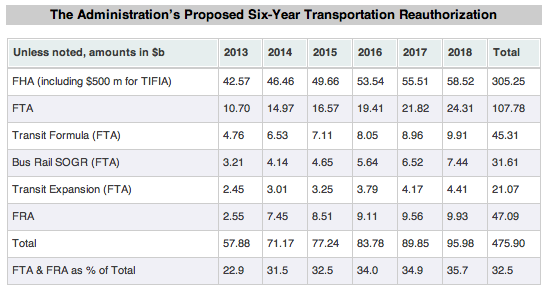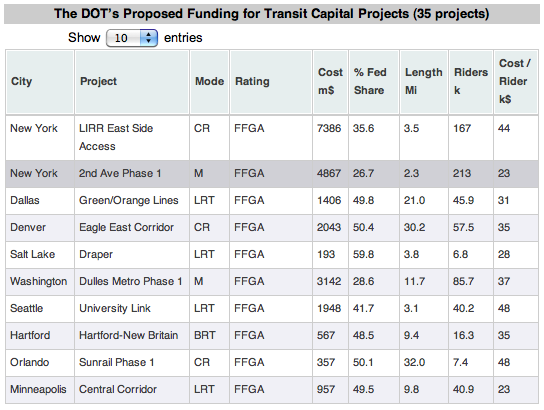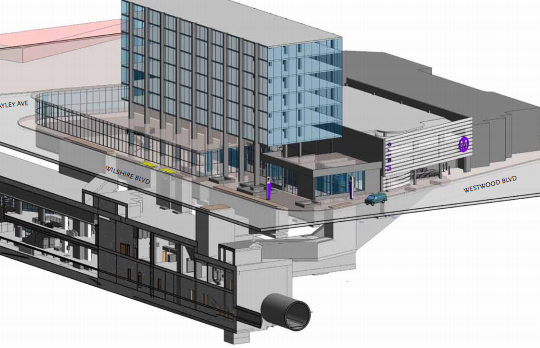This piece originally ran on The Transport Politic.
The White House has introduced a budget—and a reauthorization proposal—that would significantly increase investment in transportation infrastructure over the next six years. Though the legislation as currently designed will not be passed into law because of reluctance from Congress, the Obama administration’s continued efforts to expand funding for sustainable mobility options are to be praised.
Over the course of the next six years, the administration proposes significant expansions in transit and rail spending, increasing those programs from 22.9 percent of the overall Department of Transportation budget for surface transportation in fiscal year 2013 (and 21 percent per in actual spending in the 2011 fiscal year) to 35.7 percent of the budget in 2018. See the table below.

Though expenditures on highways would increase significantly as well, it would be in public transportation modes that the real expansion would be made. Significant spending on intercity rail—almost $50 billion over six years—as well as new transit capital projects ($21 billion) and state of good repair (SOGR, at $32 billion) would be the most important contributions of the program.
In addition to revenues from the fuel tax (which no one seems willing to advocate increasing), the White House proposes to pay for its transportation bill by reducing the size of the Overseas Contingency Operations fund, which is used to support armed operations abroad. Because of the decision to pull out of Iraq and Afghanistan, the amount of money needed for this purpose is lessened, and thus the possibility of expanding spending on transportation.
Most of the President’s proposal is unlikely to see the light of day in the House of Representatives, controlled by Republicans newly hostile to the idea of using Highway Trust Fund revenues to pay for transit projects. Yet their proposal would create a $78 billion funding shortfall in the Highway Trust Fund over the next ten years, according to an analysis by the Congressional Budget Office. That’s with $0 committed to transit! The Administration proposal, on the other hand, is fully funded (or at least accounted for*) and would transform the Highway Trust Fund into the much more reasonably titled Transportation Trust Fund; the priorities of each piece of legislation are very clear.
The defection of several House Republicans away from their own party’s transportation bill suggests that the legislation may not even get out of their chamber. At this point, the Senate’s bipartisan, mostly status-quo-extending two-year transportation reauthorization bill is now the most likely of all three proposals to be official government policy by the end of the spring. But even it faces the strong possibility of being ditched in favor of a simple extension of the existing bill, which will expire on March 31 according to the current law.
Nonetheless, the Obama administration’s plans for this expansion in transit funding, which mirror similar proposals from previous years, are a reminder of the ambitions for improved transportation that are possible in this country but continue to be derailed by political forces hostile to the idea of investing in the nation’s infrastructure. This is a serious proposal to significantly improve the state of the nation’s rail and bus systems—if we choose to take it.
More definite than any of the recommendations for an expansion in funding are the Obama administration’s recommendations for new capital investment projects. The Federal Transit Administration contributes a significant portion of costs for new rail and bus lines in the United States through the New Starts and Small Starts programs, though the Department of Transportation is recommending that these simply be merged into a new Transit Expansion and Livable Communities Program, which would also include grants for projects currently funded by the TIGER program.
The major news is that the FTA will recommend pledging its support with Full Funding Grant Agreements (FFGA) soon to four new major rail projects—the Charlotte Northeast Corridor light rail, the Los Angeles Regional Connector light rail subway, the Los Angeles Westside Subway, and the Columbia River Crossing Project light rail line in Portland—in addition to five other rail projects that will receive that funding guarantee a bit soon—a South Sacramento light rail line, San Francisco’s Central Subway, Honolulu’s Rail project, San Jose’s BART extension and the Portland-Milwaukee light rail line. See the chart below. The latter projects are all under construction; the former group will get underway either by the end of the year or in 2013.
In addition, the FTA will fund nine bus rapid transit lines with the Project Construction Grant Agreements (PCGA) across the country. Of course the twelve major projects that already have FFGAs will continue to be funded, including New York’s two megaprojects, the Second Avenue Subway and East Side Access for the Long Island Railroad.

* “Fully funded,” of course, is a nebulous term: Does money saved from pulling out of overseas military conflicts “count” as money to be spent somewhere else? The administration says yes, while Republicans in Congress say no, arguing that that money is deficitary anyway.

Yonah Freemark is a senior research associate in the Metropolitan Housing and Communities Policy Center at the Urban Institute, where he is the research director of the Land Use Lab at Urban. His research focuses on the intersection of land use, affordable housing, transportation, and governance.







_600_350_80_s_c1.jpg)








